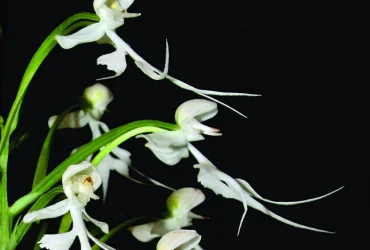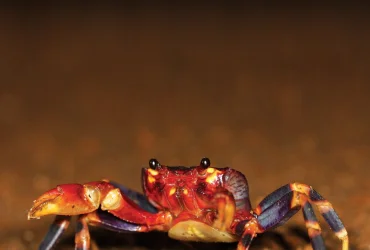Archives
 v7i3.185
v7i3.185ISSN: 1800-427X (print)
eISSN: 1800-427X (online)
Alfred Russel Wallace Centenary Issue
DOI:10.47605/tapro.v7i3.185
Proceedings of the Second International Conference on Alfred Russel Wallace and the Wallacea
Organised by the Indonesian Academy of Sciences
Wakatobi - Indonesia (10–13 November 2013)
J. Supriatna, A.A.T. Amarasinghe, and C. Margules (Editors)
Published date: 30 July 2015
Pp. 131–142, Pls. 1–4.
MINING MICROBIAL SYMBIONTS FOR SPONGE-DERIVED NATURAL PRODUCTS: IMPLICATIONS FOR THE WALLACEA
Christine M. Theodore & Phillip Crews*
*Corresponding author. E-mail: pcrews@ucsc.edu
Abstract
The Indonesian Coral Triangle is a biodiversity hotspot bisected by the Wallace line. It is becoming clear that ecological and anthropogenic factors are impacting the region. Our research is focused on the biosynthetic products of sponges. These natural products, which are beneficial to human health, will be lost if biodiversity were to decrease. For decades, chemists have looked to marine sponges as a source of novel pharmaceuticals. Over time, there has been growing suspicion these metabolites may actually be produced by microbial symbionts. Herein, we discuss a brief history of sponge natural products chemistry. Sponge associated microorganisms and their likely role in the production of clinically relevant compounds are explored through three case studies. The potential intellectual and pharmaceutical impact locked within the sponges of the Indonesian Coral Triangle is immense. We conclude that conservation, protection and management of this resource are vital from an ecological and human health perspective.
Key words : Bacteria, bengamide, fijianolide, Indonesian Coral Triangle, psymberin, symbiosis
eISSN: 1800-427X (online)
Alfred Russel Wallace Centenary Issue
DOI:10.47605/tapro.v7i3.185
Proceedings of the Second International Conference on Alfred Russel Wallace and the Wallacea
Organised by the Indonesian Academy of Sciences
Wakatobi - Indonesia (10–13 November 2013)
J. Supriatna, A.A.T. Amarasinghe, and C. Margules (Editors)
Published date: 30 July 2015
Pp. 131–142, Pls. 1–4.
MINING MICROBIAL SYMBIONTS FOR SPONGE-DERIVED NATURAL PRODUCTS: IMPLICATIONS FOR THE WALLACEA
Christine M. Theodore & Phillip Crews*
*Corresponding author. E-mail: pcrews@ucsc.edu
Abstract
The Indonesian Coral Triangle is a biodiversity hotspot bisected by the Wallace line. It is becoming clear that ecological and anthropogenic factors are impacting the region. Our research is focused on the biosynthetic products of sponges. These natural products, which are beneficial to human health, will be lost if biodiversity were to decrease. For decades, chemists have looked to marine sponges as a source of novel pharmaceuticals. Over time, there has been growing suspicion these metabolites may actually be produced by microbial symbionts. Herein, we discuss a brief history of sponge natural products chemistry. Sponge associated microorganisms and their likely role in the production of clinically relevant compounds are explored through three case studies. The potential intellectual and pharmaceutical impact locked within the sponges of the Indonesian Coral Triangle is immense. We conclude that conservation, protection and management of this resource are vital from an ecological and human health perspective.
Key words : Bacteria, bengamide, fijianolide, Indonesian Coral Triangle, psymberin, symbiosis
 v7i3.184
v7i3.184ISSN: 1800-427X (print)
eISSN: 1800-427X (online)
Alfred Russel Wallace Centenary Issue
DOI:10.47605/tapro.v7i3.184
Proceedings of the Second International Conference on Alfred Russel Wallace and the Wallacea
Organised by the Indonesian Academy of Sciences
Wakatobi - Indonesia (10–13 November 2013)
J. Supriatna, A.A.T. Amarasinghe, and C. Margules (Editors)
Published date: 30 July 2015
Pp. 126–130.
HOW TO PHOTOGRAPH A MOLUCCAN WOODCOCK: EXPERIENCES OF A MODERN FIELD BIOLOGIST IN WALLACEA
John C. Mittermeier*
*Corresponding author. E-mail: john.mittermeier@gmail.com
Abstract
One hundred and fifty years after Alfred Russel Wallace visited the Malay Archipelago much still remains to be discovered about the fascinating species that inhabit the islands now known as Wallacea. While modern fieldwork brings opportunities, and a few difficulties, that Wallace himself would not have imagined, many of the challenges facing field biologists in the twenty-first century are the same as those experienced by Wallace himself. Here I describe the struggles and excitement of Wallacean fieldwork through our efforts to obtain the first photographs of an endangered bird species, the Moluccan Woodcock Scolopax rochussenii, on Obi Island in the Northern Moluccas.
Key words : endangered, field biologists, fieldwork, Northern Moluccas, Obi Island
eISSN: 1800-427X (online)
Alfred Russel Wallace Centenary Issue
DOI:10.47605/tapro.v7i3.184
Proceedings of the Second International Conference on Alfred Russel Wallace and the Wallacea
Organised by the Indonesian Academy of Sciences
Wakatobi - Indonesia (10–13 November 2013)
J. Supriatna, A.A.T. Amarasinghe, and C. Margules (Editors)
Published date: 30 July 2015
Pp. 126–130.
HOW TO PHOTOGRAPH A MOLUCCAN WOODCOCK: EXPERIENCES OF A MODERN FIELD BIOLOGIST IN WALLACEA
John C. Mittermeier*
*Corresponding author. E-mail: john.mittermeier@gmail.com
Abstract
One hundred and fifty years after Alfred Russel Wallace visited the Malay Archipelago much still remains to be discovered about the fascinating species that inhabit the islands now known as Wallacea. While modern fieldwork brings opportunities, and a few difficulties, that Wallace himself would not have imagined, many of the challenges facing field biologists in the twenty-first century are the same as those experienced by Wallace himself. Here I describe the struggles and excitement of Wallacean fieldwork through our efforts to obtain the first photographs of an endangered bird species, the Moluccan Woodcock Scolopax rochussenii, on Obi Island in the Northern Moluccas.
Key words : endangered, field biologists, fieldwork, Northern Moluccas, Obi Island
 v7i3.183
v7i3.183ISSN: 1800-427X (print)
eISSN: 1800-427X (online)
Alfred Russel Wallace Centenary Issue
DOI:10.47605/tapro.v7i3.183
Proceedings of the Second International Conference on Alfred Russel Wallace and the Wallacea
Organised by the Indonesian Academy of Sciences
Wakatobi - Indonesia (10–13 November 2013)
J. Supriatna, A.A.T. Amarasinghe, and C. Margules (Editors)
Published date: 30 July 2015
Pp. 120–125.
ALFRED RUSSEL WALLACE AND NATURAL SELECTION: THE REAL STORY
George W. Beccaloni*
*Corresponding author. E-mail: g.beccaloni@nhm.ac.uk
Abstract
Alfred Russel Wallace (1823–1913) was a largely self-educated British naturalist, who co-published the theory of evolution by natural selection with Charles Darwin in 1858, fifteen months before Darwin’s book Origin of species was released. Some have suggested that Wallace’s independent discovery of natural selection in Indonesia in February of that year was merely fortuitous, but in fact it was the culmination of a concerted 10 year personal quest to understand how evolutionary change takes place. Although Wallace was showered with prestigious honours and awards for his great discovery, and in spite of the fact that he became one of the most famous people in the world towards the end of his life, his intellectual legacy was rapidly overshadowed by Charles Darwin’s after his death.
Key words : Charles Lyell, Joseph Hooker, Linnean Society, Malay Archipelago
eISSN: 1800-427X (online)
Alfred Russel Wallace Centenary Issue
DOI:10.47605/tapro.v7i3.183
Proceedings of the Second International Conference on Alfred Russel Wallace and the Wallacea
Organised by the Indonesian Academy of Sciences
Wakatobi - Indonesia (10–13 November 2013)
J. Supriatna, A.A.T. Amarasinghe, and C. Margules (Editors)
Published date: 30 July 2015
Pp. 120–125.
ALFRED RUSSEL WALLACE AND NATURAL SELECTION: THE REAL STORY
George W. Beccaloni*
*Corresponding author. E-mail: g.beccaloni@nhm.ac.uk
Abstract
Alfred Russel Wallace (1823–1913) was a largely self-educated British naturalist, who co-published the theory of evolution by natural selection with Charles Darwin in 1858, fifteen months before Darwin’s book Origin of species was released. Some have suggested that Wallace’s independent discovery of natural selection in Indonesia in February of that year was merely fortuitous, but in fact it was the culmination of a concerted 10 year personal quest to understand how evolutionary change takes place. Although Wallace was showered with prestigious honours and awards for his great discovery, and in spite of the fact that he became one of the most famous people in the world towards the end of his life, his intellectual legacy was rapidly overshadowed by Charles Darwin’s after his death.
Key words : Charles Lyell, Joseph Hooker, Linnean Society, Malay Archipelago
 v7i2.166
v7i2.166ISSN: 1800-427X (print)
eISSN: 1800-427X (online)
DOI:10.47605/tapro.v7i2.166
Submitted date: 9 July 2014
Accepted date: 17 July 2014
Published date: 20 February 2015
Pp. 68–71, Pls. 1–2.
DISCOVERY OF THE CRITICALLY ENDANGERED BULBOUS HERB Crinum woodrowii (AMARYLLIDACEAE) & ITS NEOTYPIFICATION
R. Kr. Singh* & Arti Garg
*Corresponding author. E-mail: rksbsiadsingh@yahoo.co.in
Abstract
A single population of a critically endangered species, Crinum woodrowii, was discovered from Katraj Ghat, Pune District, Maharashtra, at a location other than its type location. A neotype of the species is designated here and its detailed description, distribution, habitat, IUCN threat status, and nomenclatural notes are provided.
Key words : habitat, Katraj Ghat, Maharashtra, neotype, new locality, taxonomy
Section Editor: James L. Reveal
eISSN: 1800-427X (online)
DOI:10.47605/tapro.v7i2.166
Submitted date: 9 July 2014
Accepted date: 17 July 2014
Published date: 20 February 2015
Pp. 68–71, Pls. 1–2.
DISCOVERY OF THE CRITICALLY ENDANGERED BULBOUS HERB Crinum woodrowii (AMARYLLIDACEAE) & ITS NEOTYPIFICATION
R. Kr. Singh* & Arti Garg
*Corresponding author. E-mail: rksbsiadsingh@yahoo.co.in
Abstract
A single population of a critically endangered species, Crinum woodrowii, was discovered from Katraj Ghat, Pune District, Maharashtra, at a location other than its type location. A neotype of the species is designated here and its detailed description, distribution, habitat, IUCN threat status, and nomenclatural notes are provided.
Key words : habitat, Katraj Ghat, Maharashtra, neotype, new locality, taxonomy
Section Editor: James L. Reveal
 v7i1.148
v7i1.148ISSN: 1800-427X (print)
eISSN: 1800-427X (online)
DOI:10.47605/tapro.v7i1.148
Submitted date: 1 October 2014
Accepted date: 20 November 2014
Published date: 19 January 2015
Pp. 1–7, Pl. 1–3.
A NEW MONTANE SPECIES OF THE GENUS Pareas WAGLER, 1830 (SQUAMATA: PAREATIDAE) FROM NORTHERN MYANMAR
Gernot Vogel*
*Corresponding author. E-mail: gernot.vogel@t-online.de
Abstract
A new species of the genus Pareas is described from northern Myanmar. It differs from all other known species of the genus by coloration, which is mainly uniform, and its size (one of the largest species in the genus). Furthermore it is characterized by a low number of supralabials (six), a loreal that touches the orbit, presence of a presubocular and absence of a preocular. The new species was found at an elevation of 1890 m a.s.l. and is regarded as an inhabitant of high elevation mountainous areas.
Key words : Asia, Colubroidea, Oriental region, Pareas vindumi sp. nov., taxonomy
Section Editor: Olivier S.G. Pauwels
eISSN: 1800-427X (online)
DOI:10.47605/tapro.v7i1.148
Submitted date: 1 October 2014
Accepted date: 20 November 2014
Published date: 19 January 2015
Pp. 1–7, Pl. 1–3.
A NEW MONTANE SPECIES OF THE GENUS Pareas WAGLER, 1830 (SQUAMATA: PAREATIDAE) FROM NORTHERN MYANMAR
Gernot Vogel*
*Corresponding author. E-mail: gernot.vogel@t-online.de
Abstract
A new species of the genus Pareas is described from northern Myanmar. It differs from all other known species of the genus by coloration, which is mainly uniform, and its size (one of the largest species in the genus). Furthermore it is characterized by a low number of supralabials (six), a loreal that touches the orbit, presence of a presubocular and absence of a preocular. The new species was found at an elevation of 1890 m a.s.l. and is regarded as an inhabitant of high elevation mountainous areas.
Key words : Asia, Colubroidea, Oriental region, Pareas vindumi sp. nov., taxonomy
Section Editor: Olivier S.G. Pauwels
Hubungi Kami
The ultimate aim of the journal is to provide an effective medium for communication of the latest and best scientific information.
Copyright © 2020 Taprobanica. All Rights Reserved
Jasa Pembuatan Website by IKT




